The Mechanisms of Inhibition Effects on Bubble Growth in He-Irradiated 316L Stainless Steel Fabricated by Selective Laser Melting
Abstract
:1. Introduction
2. Material and Methods
3. Results and Discussion
3.1. Microstructures of the Pristine Samples
3.2. He Bubbles in CR 316L and SLM 316L Samples
3.3. Effects of SGBs on the Bubbles in SLM 316L
3.4. Effects of Nano-Scale Oxide Particles on the Bubbles in SLM 316L
3.5. Difference in He Density inside the Bubbles between CR 316L and SLM 316L
4. Conclusions
- Under the same He irradiation condition, the average diameter of He bubbles in the SLM 316L sample is smaller than that in the CR 316L sample, while the bubble densities are basically consistent in both types of 316L.
- The effects of unique sub-grain boundaries have primary contributions to the decreased bubble diameter in SLM 316L, especially at low irradiation dose conditions. However, the nano-sized oxide particles with low local density may not be efficient sinks for irradiation defects, nor the main factor that dominates the decreased bubble diameter in SLM 316L for the irradiation condition in this study.
- The detectable differences in He densities inside the bubbles were found in SLM 316L and CR 316L via EELS measurements. The inhibition effects of increased He density on bubble growth were explained as two mechanisms: Firstly, increased He densities have an inhibition effect on the coalescence of small bubbles. Secondly, high He densities can stabilize the bubbles and reduce reabsorbed vacancies.
- The differences in He density inside the bubbles with different diameters in SLM 316L and CR 316L follow a linear deceasing trend, which is attributed to the combination of the Young–Laplace law and internal stress fields in SLM 316L. It indicates that, in SLM 316L, the stress-dominated increase in He density is more significant in small-sized bubbles than that in bubbles with large sizes.
Supplementary Materials
Author Contributions
Funding
Data Availability Statement
Acknowledgments
Conflicts of Interest
References
- Zinkle, S.J.; Was, G.S. Materials challenges in nuclear energy. Acta Mater. 2013, 61, 735–758. [Google Scholar] [CrossRef]
- Ngo, T.D.; Kashani, A.; Imbalzano, G.; Nguyen, K.T.Q.; Hui, D. Additive manufacturing (3D printing): A review of materials, methods, applications and challenges. Compos. Part B Eng. 2018, 143, 172–196. [Google Scholar] [CrossRef]
- Frazier, W.E. Metal Additive Manufacturing: A Review. J. Mater. Eng. Perform. 2014, 23, 1917–1928. [Google Scholar] [CrossRef]
- Herzog, D.; Seyda, V.; Wycisk, E.; Emmelmann, C. Additive manufacturing of metals. Acta Mater. 2016, 117, 371–392. [Google Scholar] [CrossRef]
- Shamsujjoha, M.; Agnew, S.R.; Fitz-Gerald, J.M.; Moore, W.R.; Newman, T.A. High strength and ductility of additively manufactured 316L stainless steel explained. Metall. Mater. Trans. A 2018, 49, 3011–3027. [Google Scholar] [CrossRef]
- Liverani, E.; Toschi, S.; Ceschini, L.; Fortunato, A. Effect of selective laser melting (SLM) process parameters on microstructure and mechanical properties of 316L austenitic stainless steel. J. Mater. Process. Technol. 2017, 249, 255–263. [Google Scholar] [CrossRef]
- Lin, J.; Chen, F.; Tang, X.; Liu, J.; Shen, S.; Ge, G. Radiation-induced swelling and hardening of 316L stainless steel fabricated by selected laser melting. Vacuum 2020, 174, 109183. [Google Scholar] [CrossRef]
- Sun, X.; Chen, F.; Huang, H.; Lin, J.; Tang, X. Effects of interfaces on the helium bubble formation and radiation hardening of an austenitic stainless steel achieved by additive manufacturing. Appl. Surf. Sci. 2019, 467–468, 1134–1139. [Google Scholar] [CrossRef]
- Shang, Z.; Fan, C.; Xue, S.; Ding, J.; Li, J.; Voisin, T.; Wang, Y.M.; Wang, H.; Zhang, X. Response of solidification cellular structures in additively manufactured 316 stainless steel to heavy ion irradiation: An in situ study. Mater. Res. Lett. 2019, 7, 290–297. [Google Scholar] [CrossRef]
- Jiang, L.; Song, M.; Yang, L.; Yang, J.; Du, D.; Lou, X.; Chen, Y. A comparison study of void swelling in additively manufactured and cold-worked 316L stainless steels under ion irradiation. J. Nucl. Mater. 2021, 551, 152946. [Google Scholar] [CrossRef]
- Shang, Z.; Fan, C.; Ding, J.; Xue, S.; Gabriel, A.; Shao, L.; Voisin, T.; Wang, Y.M.; Niu, T.; Li, J.; et al. Heavy ion irradiation response of an additively manufactured 316LN stainless steel. J. Nucl. Mater. 2021, 546, 152745. [Google Scholar] [CrossRef]
- Prashanth, K.G.; Eckert, J. Formation of metastable cellular microstructures in selective laser melted alloys. J. Alloys Compd. 2017, 707, 27–34. [Google Scholar] [CrossRef]
- Fu, C.; Li, J.; Bai, J.; Lei, Q.; Liu, R.; Lin, J. Evolution of helium bubbles in SLM 316L stainless steel irradiated with helium ions at different temperatures. J. Nucl. Mater. 2022, 562, 153609. [Google Scholar] [CrossRef]
- Song, M.; Wang, M.; Lou, X.; Rebak, R.B.; Was, G.S. Radiation damage and irradiation-assisted stress corrosion cracking of additively manufactured 316L stainless steels. J. Nucl. Mater. 2019, 513, 33–44. [Google Scholar] [CrossRef]
- Sun, Z.; Xu, Y.; Chen, F.; Shen, L.; Tang, X.; Sun, L.; Fan, M.; Huang, P. Effects of ion irradiation on microstructure of 316L stainless steel strengthened by disperse nano TiC through selective laser melting. Mater. Charact. 2021, 180, 111420. [Google Scholar] [CrossRef]
- Rouvière, J.L.; Sarigiannidou, E. Theoretical discussions on the geometrical phase analysis. Ultramicroscopy 2005, 106, 1–17. [Google Scholar] [CrossRef]
- Walsh, C.A.; Yuan, J.; Brown, L.M. A procedure for measuring the helium density and pressure in nanometer-sized bubbles in irradiated materials using electron-energy-loss spectroscopy. Philos. Mag. A 2000, 80, 1507–1543. [Google Scholar] [CrossRef]
- Wang, X.; Jin, K.; Chen, D.; Bei, H.; Wang, Y.; Weber, W.J.; Zhang, Y.; More, K.L. Effects of Fe concentration on helium bubble formation in NiFex single-phase concentrated solid solution alloys. Materialia 2019, 5, 100183. [Google Scholar] [CrossRef]
- Liu, L.; Ding, Q.; Zhong, Y.; Zou, J.; Wu, J.; Chiu, Y.-L.; Li, J.; Zhang, Z.; Yu, Q.; Shen, Z. Dislocation network in additive manufactured steel breaks strength–ductility trade-off. Mater. Today 2018, 21, 354–361. [Google Scholar] [CrossRef]
- Bertsch, K.M.; de Bellefon, G.M.; Kuehl, B.; Thoma, D.J. Origin of dislocation structures in an additively manufactured austenitic stainless steel 316L. Acta Mater. 2020, 199, 19–33. [Google Scholar] [CrossRef]
- Jumel, S.; Van Duysen, J.-C.; Ruste, J.; Domain, C. Interactions between dislocations and irradiation-induced defects in light water reactor pressure vessel steels. J. Nucl. Mater. 2005, 346, 79–97. [Google Scholar] [CrossRef]
- Li, S.; Hu, J.; Chen, W.-Y.; Yu, J.; Li, M.; Wang, Y. Evolution of cellular dislocation structures and defects in additively manufactured austenitic stainless steel under ion irradiation. Scr. Mater. 2020, 178, 245–250. [Google Scholar] [CrossRef]
- Christien, F.; Barbu, A. Cluster Dynamics modelling of irradiation growth of zirconium single crystals. J. Nucl. Mater. 2009, 393, 153–161. [Google Scholar] [CrossRef]
- Du, J.; Jiang, S.; Cao, P.; Xu, C.; Wu, Y.; Chen, H.; Fu, E.; Lu, Z. Superior radiation tolerance via reversible disordering–ordering transition of coherent superlattices. Nat. Mater. 2023, 22, 442–449. [Google Scholar] [CrossRef]
- Auger, M.A.; Hoelzer, D.T.; Field, K.G.; Moody, M.P. Nanoscale analysis of ion irradiated ODS 14YWT ferritic alloy. J. Nucl. Mater. 2020, 528, 151852. [Google Scholar] [CrossRef]
- Chen, Y.; Fu, E.; Yu, K.; Song, M.; Liu, Y.; Wang, Y.; Wang, H.; Zhang, X. Enhanced radiation tolerance in immiscible Cu/Fe multilayers with coherent and incoherent layer interfaces. J. Mater. Res. 2015, 30, 1300–1309. [Google Scholar] [CrossRef]
- Wu, Z.F.; Liang, Y.X.; Tang, J.J.; Wang, Y.F.; Zhang, S.L.; Meng, Q.N.; Yan, Y.; Xu, C.; Wang, J.; Shen, T.D.; et al. Enhancing the phase stability of TiNi intermetallic compound via nanocrystallization in an irradiated multicomponent vanadium alloy. Mater. Des. 2022, 213, 110298. [Google Scholar] [CrossRef]
- Chang, Y.-Q.; Guo, Q.; Zhang, J.; Chen, L.; Long, Y.; Wan, F.-R. Irradiation effects on nanocrystalline materials. Front. Mater. Sci. 2013, 7, 143–155. [Google Scholar] [CrossRef]
- Wu, Z.; Zhou, X.; Liu, J.; Du, J.; Zou, S.; Huang, Y.; Huang, Q.; Yang, K.J.; Zhang, J.; Huang, J.; et al. Ultrafine-grained W alloy prepared by SPS with high thermal stability and excellent irradiation resistance. Nucl. Fusion 2020, 60, 036006. [Google Scholar] [CrossRef]
- El-Atwani, O.; Nathaniel, J.E.; Leff, A.C.; Muntifering, B.R.; Baldwin, J.K.; Hattar, K.; Taheri, M.L. The role of grain size in He bubble formation: Implications for swelling resistance. J. Nucl. Mater. 2017, 484, 236–244. [Google Scholar] [CrossRef]
- Deo, C.S.; Okuniewski, M.A.; Strivilliputhur, S.G.; Maloy, S.A.; Baskes, M.I.; James, M.R.; Stubbins, J.F. Helium bubble nucleation in bcc iron studied by kinetic Monte Carlo simulations. J. Nucl. Mater. 2007, 361, 141–148. [Google Scholar] [CrossRef]
- Fréchard, S.; Walls, M.; Kociak, M.; Chevalier, J.P.; Henry, J.; Gorse, D. Study by EELS of helium bubbles in a martensitic steel. J. Nucl. Mater. 2009, 393, 102–107. [Google Scholar] [CrossRef]
- Taverna, D.; Kociak, M.; Stéphan, O.; Fabre, A.; Finot, E.; Décamps, B.; Colliex, C. Probing physical properties of confined fluids within individual nanobubbles. Phys. Rev. Lett. 2008, 100, 035301. [Google Scholar] [CrossRef] [PubMed]
- Was, G.S. Fundamentals of Radiation Materials Science: Metals and Alloys; Springer: New York, NY, USA, 2007. [Google Scholar]
- Trinkaus, H.; Singh, B.N. Helium accumulation in metals during irradiation—Where do we stand? J. Nucl. Mater. 2003, 323, 229–242. [Google Scholar] [CrossRef]
- Deng, H.Q.; Hu, W.Y.; Gao, F.; Heinisch, H.L.; Hu, S.Y.; Li, Y.L.; Kurtz, R.J. Diffusion of small He clusters in bulk and grain boundaries in α-Fe. J. Nucl. Mater. 2013, 442, S667–S673. [Google Scholar] [CrossRef]
- Golubov, S.I.; Stoller, R.E.; Zinkle, S.J.; Ovcharenko, A.M. Kinetics of coarsening of helium bubbles during implantation and post-implantation annealing. J. Nucl. Mater. 2007, 361, 149–159. [Google Scholar] [CrossRef]
- Morishita, K.; Sugano, R.; Wirth, B.D. MD and KMC modeling of the growth and shrinkage mechanisms of helium–vacancy clusters in Fe. J. Nucl. Mater. 2003, 323, 243–250. [Google Scholar] [CrossRef]
- Evin, B.; Leroy, E.; Segard, M.; Paul-Boncour, V.; Challet, S.; Fabre, A.; Latroche, M. Investigation by STEM-EELS of helium density in nanobubbles formed in aged palladium tritides. J. Alloys Compd. 2021, 878, 160267. [Google Scholar] [CrossRef]
- David, M.-L.; Alix, K.; Pailloux, F.; Mauchamp, V.; Couillard, M.; Botton, G.A.; Pizzagalli, L. In situ controlled modification of the helium density in single helium-filled nanobubbles. J. Appl. Phys. 2014, 115, 123508. [Google Scholar] [CrossRef]
- Egerton, R.F. Electron Energy-Loss Spectroscopy in the Electron Microscope, 3rd ed.; Springer: New York, NY, USA, 2011. [Google Scholar] [CrossRef]
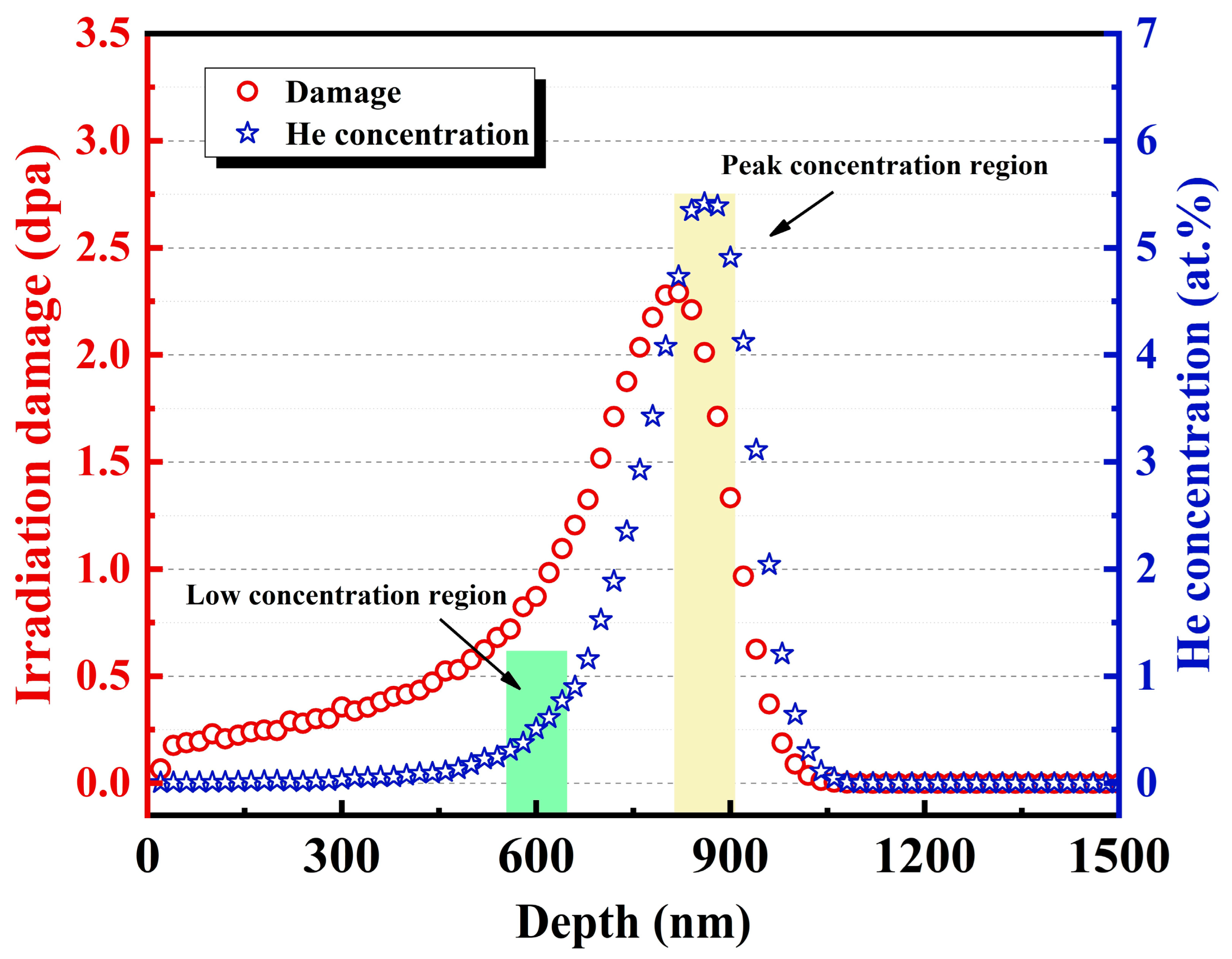
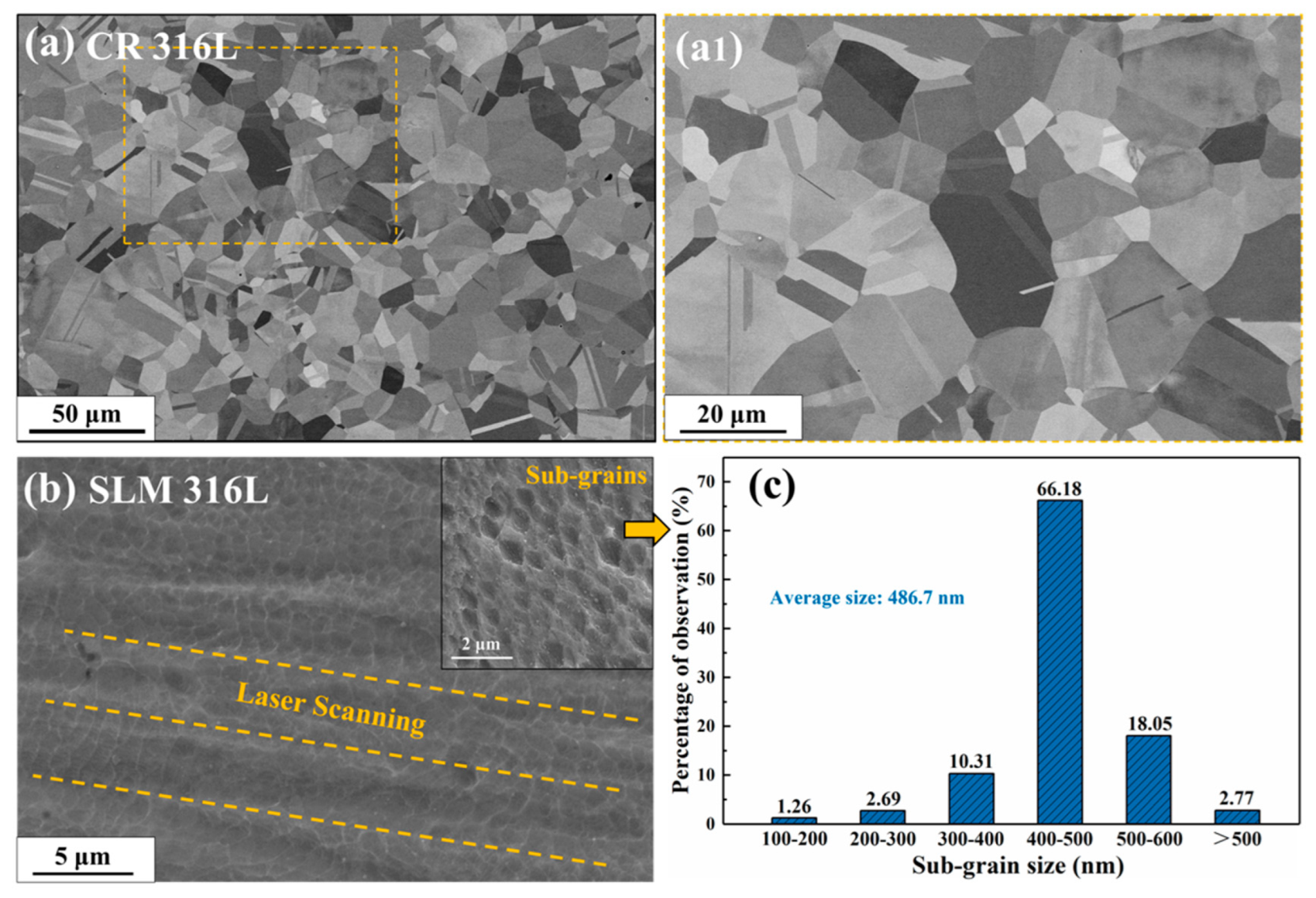


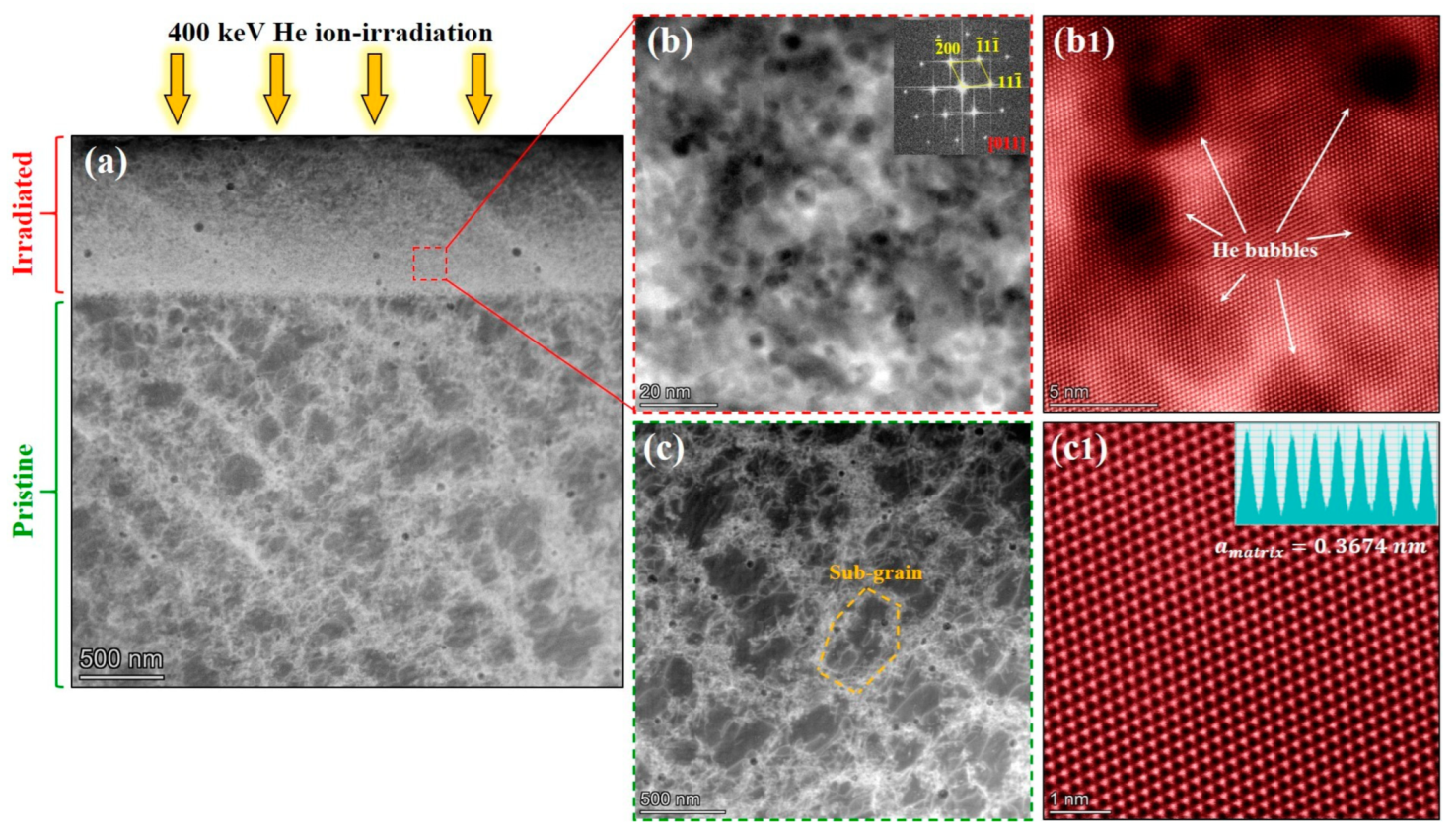


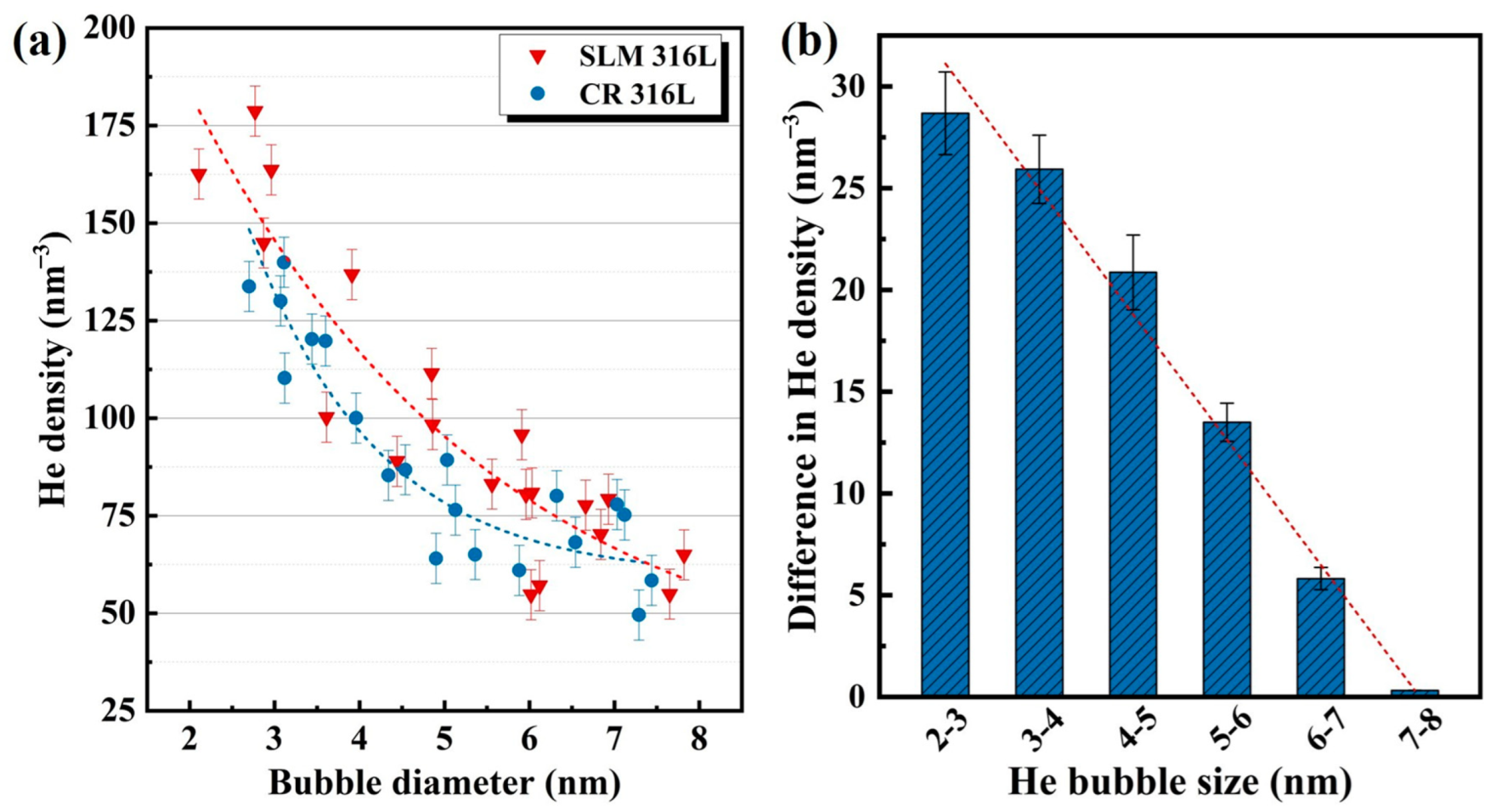

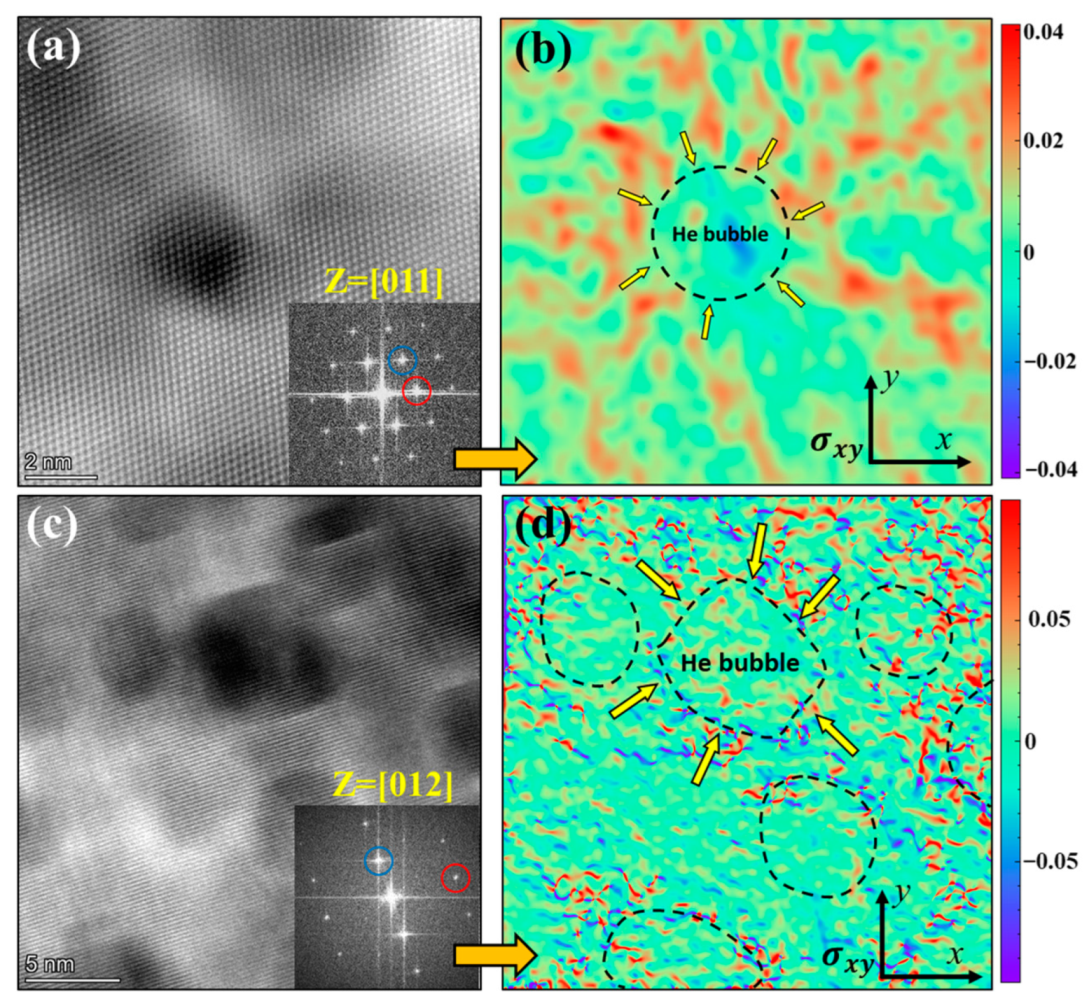

| Fe | Cr | Ni | Mo | Mn | Si | C | S/P | |
|---|---|---|---|---|---|---|---|---|
| CR 316L | Bal. | 16.94 | 10.50 | 2.07 | 1.18 | 0.29 | 0.02 | <0.01 |
| SLM 316L | Bal. | 17.22 | 10.15 | 2.25 | 1.06 | 0.43 | 0.02 | <0.01 |
Disclaimer/Publisher’s Note: The statements, opinions and data contained in all publications are solely those of the individual author(s) and contributor(s) and not of MDPI and/or the editor(s). MDPI and/or the editor(s) disclaim responsibility for any injury to people or property resulting from any ideas, methods, instructions or products referred to in the content. |
© 2023 by the authors. Licensee MDPI, Basel, Switzerland. This article is an open access article distributed under the terms and conditions of the Creative Commons Attribution (CC BY) license (https://creativecommons.org/licenses/by/4.0/).
Share and Cite
Shen, S.; Sun, Z.; Hao, L.; Liu, X.; Zhang, J.; Yang, K.; Liu, P.; Tang, X.; Fu, E. The Mechanisms of Inhibition Effects on Bubble Growth in He-Irradiated 316L Stainless Steel Fabricated by Selective Laser Melting. Materials 2023, 16, 3922. https://doi.org/10.3390/ma16113922
Shen S, Sun Z, Hao L, Liu X, Zhang J, Yang K, Liu P, Tang X, Fu E. The Mechanisms of Inhibition Effects on Bubble Growth in He-Irradiated 316L Stainless Steel Fabricated by Selective Laser Melting. Materials. 2023; 16(11):3922. https://doi.org/10.3390/ma16113922
Chicago/Turabian StyleShen, Shangkun, Zhangjie Sun, Liyu Hao, Xing Liu, Jian Zhang, Kunjie Yang, Peng Liu, Xiaobin Tang, and Engang Fu. 2023. "The Mechanisms of Inhibition Effects on Bubble Growth in He-Irradiated 316L Stainless Steel Fabricated by Selective Laser Melting" Materials 16, no. 11: 3922. https://doi.org/10.3390/ma16113922






